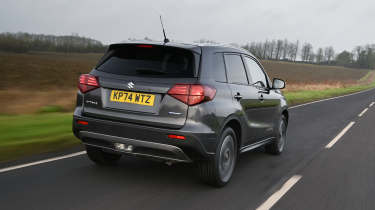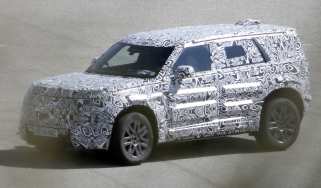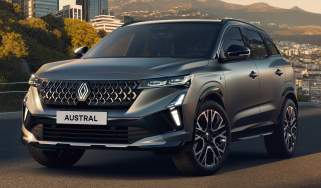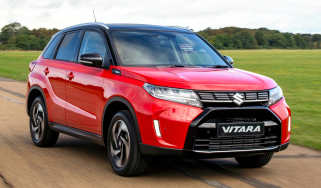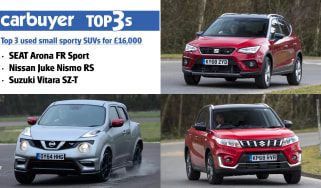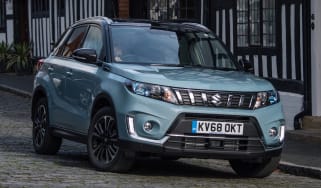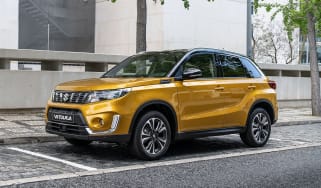Suzuki Vitara review – a good to drive, but outdated small SUV
“The Suzuki Vitara is an affordable, practical and reliable small SUV that’s good to drive”
Pros
- Lots of equipment
- Sporty engines
- Sharp design
Cons
- Not the most economical
- Brittle interior plastics
- Artificial-feeling steering
Verdict – is the Suzuki Vitara a good car?
The Suzuki Vitara name has been around for a long time and the car itself has become known over that time for being a reliable and rugged small SUV. Older versions were very capable off-roaders, and while the current model isn’t bad in the mud, it’s much more focused on being good to drive on-road. It’s getting on a bit now, though, and 10 years on from its launch it’s showing its age.
Suzuki Vitara models, specs and alternatives
The Suzuki Vitara is a small SUV that’s similar in size to rivals like the Nissan Juke, Peugeot 2008, Renault Captur and Toyota C-HR. It’s positioned as a more budget-friendly alternative to those models, though, and is ageing in comparison, the latest model having been around since 2015.
There’s no problem with offering a model with slightly older underpinnings if it’s budget friendly, but it’s hard to say whether that’s still the case with the latest Vitara. It starts from just under £27,000, while the Mazda CX-30 will set you back a whole £1,000 less in entry-level guise, and it feels a whole lot more premium. In a head-to-head with that car, we crowned the CX-30 the winner, but you might choose something like the Vitara if reliability is a priority, because Suzuki is unbeatable in this area, according to our Driver Power owner satisfaction survey.
In 2022 a new full hybrid was added to the range alongside the existing mild-hybrid petrol. The difference between them is that the full-hybrid model has a large motor and battery able to drive the wheels, while the mild-hybrid version simply has a tiny motor attached to a normal petrol engine that boosts efficiency – you don’t notice it when driving.
The Suzuki Vitara underwent another facelift in 2024, following revisions in 2020 and 2018. You’d be forgiven for missing the updates, though, because the general look of the Vitara is still mostly the same as before, save a new grille and some other subtle tweaks. Overall, the Suzuki Vitara’s look is rather plain compared to rivals, and it wears its boxy look unashamedly, rather than hiding its status as an SUV with swoopy lines.
The interior is perhaps the Vitara’s weakest area, as it uses quite a lot of hard plastics that mean it feels a little cheap and downmarket. However, it's well built and should last a long time if treated well, plus it has a five-star safety rating, so true to Suzuki’s reputation it is a well-engineered little car.
Petrol and diesel engines were available in the Vitara previously, but now there are petrol and full hybrid models only, with no diesel in sight. The 1.4-litre ‘BoosterJet’ petrol is the base model and uses mild-hybrid technology, is available with four-wheel drive (Suzuki calls this ALLGRIP) and uses a six-speed manual gearbox.
The other engine option is the full-hybrid Vitara that uses a 1.5-litre petrol engine along with a 33bhp electric motor and a 0.84kWh battery for a total output of 113bhp. This version uses a six-speed automatic gearbox, and can return up to 54.3mpg while emitting 119g/km of CO2.
Unfortunately, the switch to hybrid powertrains has made the Vitara more expensive, dragging the price up to more than some of its rivals. While some may feel its increased power and economy is worth the extra outlay, a high price tag definitely doesn’t do the Vitara any favours when you consider it as an overall package.
At least the Suzuki Vitara is well equipped. Just like the Swift hatchback, the lineup now comprises just two trim levels: Motion and Ultra. As standard you get Apple CarPlay and Android Auto, keyless entry and start, a rear parking camera and sensors, blind spot monitoring and adaptive cruise control.
The Suzuki Vitara may have a five-star Euro NCAP crash-test rating, but it was tested back in 2015 when the test regime was less stringent, and the independent body considers this to have expired compared with the latest standards.
For the latest deals on the Suzuki Vitara, check out the Find a Car service on sister-site Auto Express

